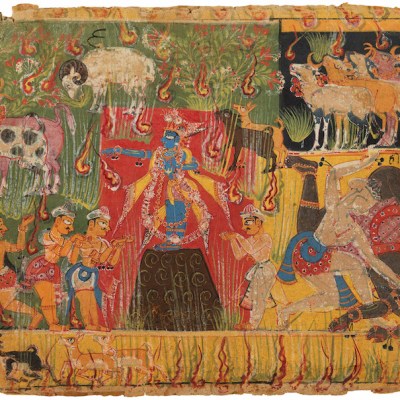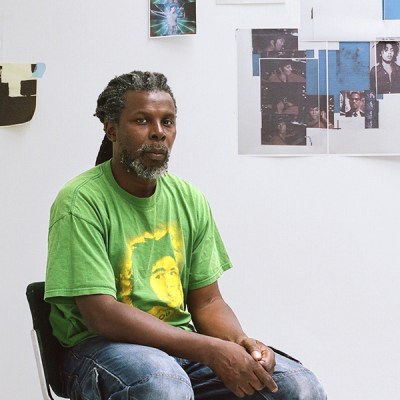Of all the works to come out of Picasso’s experiments with analytical cubism, the portraits are the most intriguing, and the most difficult. It is one thing to take apart a tabletop, to redraw and reassemble its component parts, quite another to do so with a face. Picasso’s extraordinary portrait of Daniel-Henry Kahnweiler (1910) at first seems to be a dusty, shattered mirror of a scene, with all the points of reference by which we instinctively judge character – the eyes, the profile, the turn of the mouth – scattered. Deprived of them, we must rely on the artist’s shuffled deck of clues, which include a watch chain (the art dealer was famously punctilious), clasped hands, the slick parting of his hair, and thousands of brushstrokes evoking repeated glances back and forth, from artist, to sitter, to canvas. All artists find equivalents and shorthands for the thing they study. One of the revolutionary things about cubism was that it demanded the same effort of the viewer. We too must find a way to translate. It was, and is, an exercise that rewards and frustrates in equal measure.
Daniel-Henry Kahnweiler (1910), Pablo Picasso. Art Institute of Chicago. © Succession Picasso/DACS London, 2016; 2016 Estate of Pablo Picasso/Artists Rights Society (ARS) New York
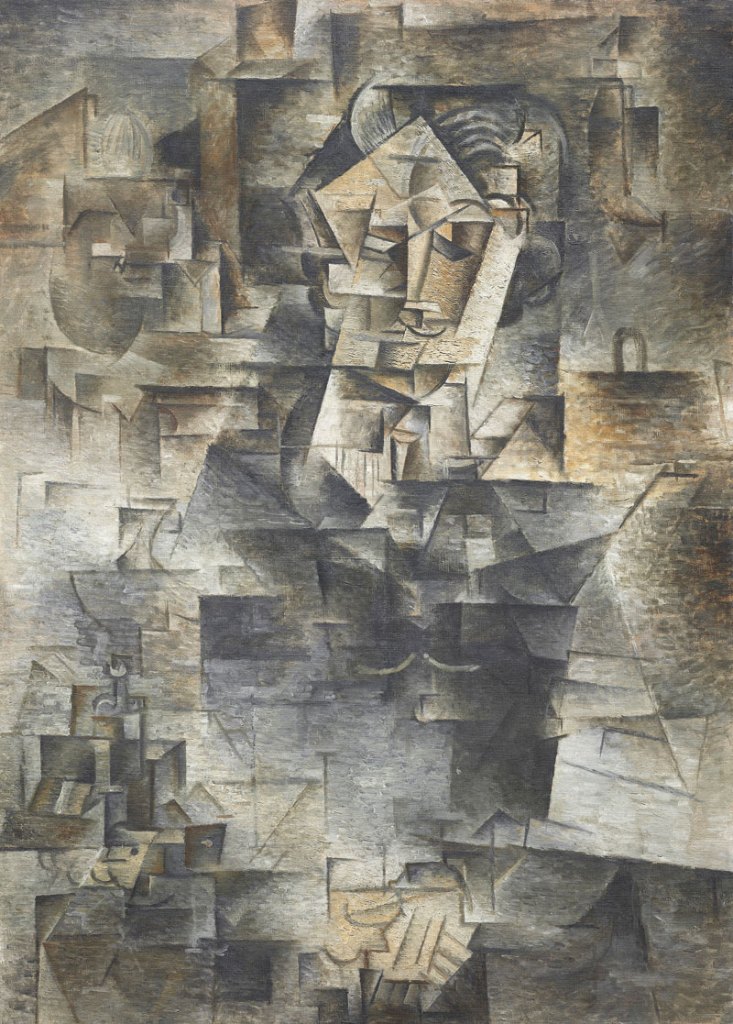
The Kahnweiler portrait is one of the most important loans in an exhibition that likewise both frustrates and rewards, which offers glimpses of its subject, but not the ones you might expect. The first major exhibition devoted to the artist’s portraits in 20 years, it spans the entirety of Picasso’s long, prolific career with an odd mixture of showstoppers and curios. The opening room of juvenile self-portraits sets the tone, and highlights the problem facing anyone who dares grapple with Picasso’s early years. Look one way, and he emerges as a brooding adolescent realist; look another, and he’s a visionary symbolist in the thrall of Munch. He even found time to paint a send-up of himself scowling in a powdered wig. Picasso was a shape-shifter, and it is fitting that the dominant work in this room is his iconic Self-portrait with Palette of 1906, in which his features are transformed into a mysterious and impenetrable mask.
Self-Portrait with Palette by Pablo Picasso © Succession Picasso/DACS, London 2016; Photograph and Digital Image Philadelphia Museum of Art © Estate of Pablo Picasso/Artists Rights Society (ARS) New York

It’s a captivating image, not least because it overturns the idea that the success of a portrait should be measured by its likeness. The curators trace this attitude to Picasso’s childhood interest in caricature, which he nurtured as a young man among Barcelona’s avant-garde in the late 1890s. Most of a room is devoted to drawings of his male companions from this period and from his early years in Paris. This plays to the strengths of the Museu Picasso in Barcelona, the NPG’s partner for this exhibition (and where it travels next spring), but the unexpected insights that the rapid, informal works offer into his social circle come at the expense of his larger and better-known Blue and Rose period paintings, which are minimally represented. As a result, the jump to Picasso’s breakthroughs of the 1910s seems abrupt.
Cubism is dealt with quickly but cogently with a series of depictions of Fernande Olivier, the first of several loose sections focusing on Picasso’s lovers and muses. (Kahnweiler, whose support made Picasso’s experiments feasible, watches from the corner.) It is fascinating to see how the artist moulded her strong, refined features to fit and inform new idioms: her hieratic profile is emphasised in a gouache of 1906, softened in a deliberately ‘unfinished’ bronze head of the same year, and then fractured into the intersecting planes of his early cubist sculpture and painting.
Portrait of Olga Picasso Private collection. © Succession Picasso/DACS London, 2016
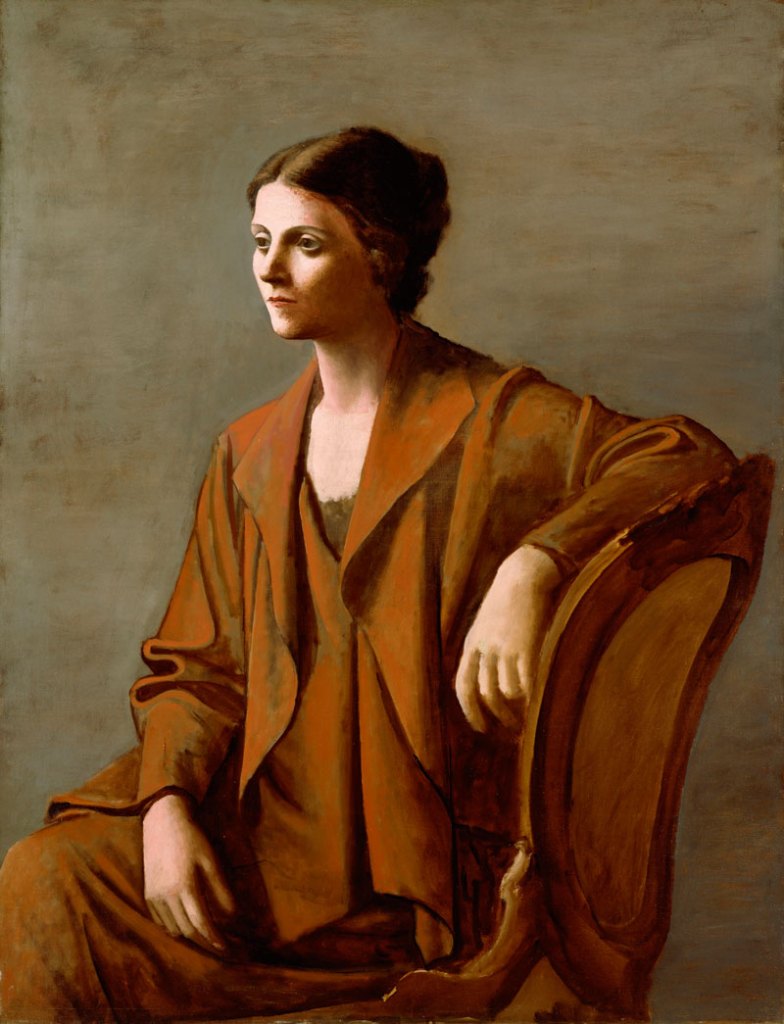
This is the most focused, in terms of sequential stylistic progression, that we see Picasso here: a sense of restlessness takes over again in the room devoted to Olga Khokhlova, his first wife. Picasso met the Ukrainian dancer in 1917 when he worked on the designs for Parade, in which she performed. Parade was an audacious carnival of boxy cubist costumes and livid colours; his celebrated portrait of his wife, made six years later, is a masterclass in modern classicism, balanced by two intersecting diagonals that stretch down her right arm and along her left shoulder, and executed in an austere palette of bole reds, browns and chalky white. By 1935, the year their marriage fully deteriorated, his style had fragmented again too: Olga’s staring eyes and the sickly green crescent moon of her cheek and jaw in Woman in a Hat (Olga) are loaded distortions of her luminescent features in the earlier work. There is a long, significant backstory to Picasso’s classicising 1920s painting – the much-discussed ‘return to order’ after the war, and the artist’s subsequent series of massive female figures that pushed statuesque beauty to its extreme – but in the more limited context of this exhibition, the sudden return to formal portraiture serves as a dramatic reminder of Picasso’s extraordinary versatility.
Woman in a Hat (Olga) (1935), Pablo Picasso. © Succession Picasso/DACS London

It is a nice touch that, to get to the large final room, you must pass a set of cartoons lampooning his friend and secretary, Jaime Sabartés, as a diminutive old man making advances on 1950s pin-up girls. The broad selection of works that follows, of portraits from the 1930s onwards, reveals how Picasso came to turn his unforgiving eye far more frequently on women, and in doing so turned Europe’s time-honoured ideals of feminine beauty and grace upside down. It is here, finally, that the curators’ caricature argument comes into its own, with some obviously satirical works including the famously beautiful Lee Miller grinning like a Cheshire cat, and a monstrously oversized painting of Picasso’s daughter Maya catching butterflies, her face a riot of excitement and enthusiasm. By loosely grouping images of his different muses – while setting up revealing sightlines between them – the display also reveals the subtler tricks Picasso used to capture these women on canvas. Nusch Éluard’s wryly raised eyebrow, Sylvette David’s wavy blond hair, Jacqueline Roque’s prominent, sphinx-like eyes and brow, all recur in various permutations as ciphers for the sitters, anchoring Picasso’s often extreme distortions of their faces and figures.
Self-portrait (1972), Pablo Picasso. © Succession Picasso/DACS London
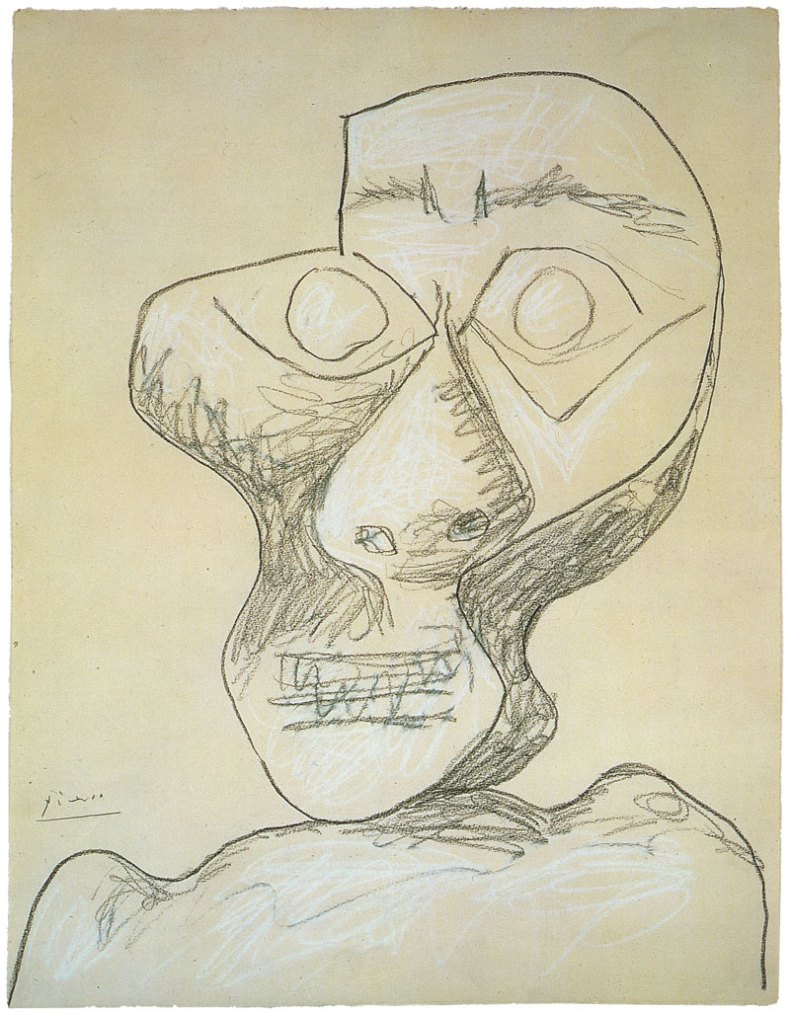
Ultimately though, the most sustained caricature that emerges is of art itself. Few people did more to send up and undermine the traditions of portraiture – but Picasso’s satire grew out of competitive respect for and rivalry with the Old Masters. In Rembrandt Holding the Hand of a Young Woman with Veil from The Vollard Suite (1934), the hairy Old Master (a jokey take on the artist’s characteristically feathery hatching) stares longingly at a serene woman in Picasso’s classicising style – as if the modern artist is extending a challenge, but also a hand, to his great predecessor. Immediately opposite, Picasso’s late Self-portrait of 1972 stares out at the room. He exaggerates his ageing features until they resemble a skull, pushing through caricature and back to a blank mask. It seems a haunting acknowledgment by the artist (who died the following year) that his own image would soon pass out of his control. The rest of us have been deconstructing and reconstructing it ever since. There is, inevitably, a lot missing from this multifaceted display, but it’s one more incomplete perspective with which to piece together your own portrait of the man.
‘Picasso Portraits’ is at the National Portrait Gallery, London, until 5 February 2016.
From the November issue of Apollo: Preview and subscribe here.

